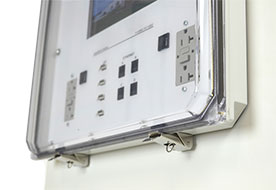If you aren’t familiar with packing an electrical box, it can seem a little intimidating. This guide is going to show you how things fit into electrical enclosures, but before getting into it, a couple of disclaimers are needed.
First, packing a box involves running electrical wires for a building. Such work must be signed off by a qualified electrician in every state in the country. This is formal electrical code and ignoring it can lead to dangerous situations, fines, and other legal consequences.
Second, this guide is not a replacement for a professional electrician. Instead, it is designed to help home and building owners understand how things fit into enclosures to better see why different arrangements need different sizes and shapes.
With all of that covered, let’s learn about electrical box packing. Keep in mind that non-metallic boxes can hold one or multiple devices, depending on their design and what you need to wire.
Arrange Your Wires First
The first thing you will do with the enclosure is feed all of the wires you need for any devices and future plans. This will include hot wires, ground, and neutral wires.
In this phase, think about where the devices will be arranged in the box (assuming it holds more than one), and orient your wires as needed to prepare for that.
Pack Free Wires
For simpler installations, every wire will attach to a device. In that case, you don’t need to run this step.
In some situations, it makes sense to prepare extra pigtails or attachments for planned changes. For instance, if you install a traditional light switch with plans to upgrade to a smart switch later, you might need to run additional free wires that work with the smart switch later (commonly an extra neutral is needed).
When you do have unattached wires in the box, make sure they are safely terminated, and go ahead and pack them before you attach your devices.
Wire the Devices
At this point, any wire that isn’t packed should attach directly to a device. On top of that, the wires should be oriented to pair with each device in the box. Wire lengths and arrangements mostly dictate where you will attach any device.
At the same time, your electrical enclosure also shows you where devices attach. Basically, you picked which device would go at each point in the enclosure, and now you can attach wires accordingly.
It’s worth a reminder that you can never over pack adjustable electrical boxes according to electrical code. Make sure the box meets space requirements for your planned installations before you start running wires.
ith all of that said, when you attach the wires in this phase, devices can really only fit one way, and that’s the way you planned originally.
Pack the Rest of the Box
With everything attached, you can pack the box, taking advantage of any of your enclosure accessories. The wires will fold in behind each device as you push it into the box for installation. Be sure not to cross any wires while you do this, but note how the devices and the wires fill space.
As long as everything was trimmed and attached according to electrical code, it will fit intuitively into the electrical enclosure. This step is just a matter of folding the wires into place and securing each device in its planned home.
From there, you can inspect your installation to make sure it looks good, and you can plate the enclosure.
